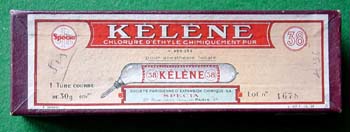 |
|
Kelen, around 1940
|
"Le chlorure d'éthyle permit aussi bien l'anesthésie rapide par inhalation que l 'anesthésie locale par le froid." "Son évaporation sur la peau consommant une grande quantité de calories, le froid ainsi provoqué permet l'apparition d'un givre provenant de la vapeur d'eau de l'air ambiant; ce phénomène permet de juger le moment opportun pour une incision d'abcès par exemple! "
This local application of chloroethyl for cold anesthesia of the skin goes back to the Geneva doctor and dentist Camille REDARD (1841-1910), who reported in 1888 on the benefits of Chloraethylsprays in his practice.
The "Handbuch der neuen Arzneimittel" by J. MINDES from 1901 writes: "Ethylene chloratum, a local anesthetic that is well tolerated, is recommended by REDARD in Geneva for dental surgery and sciatica."
- still the drug did not prevail. However, the same plant already knew the KELEN-methyl, "a mixture of chloroethyl and chloromethyl" - chloromethyl was a substitute for chloroform.
The German-speaking clinicians also used the French product KELEN. For many years, this drug remained a popular remedy for the administration of prolonged anesthetics (which was then continued with ether or chloroform). Already at the beginning of the 20th century, however, the incidents increased in this procedure: quite unexpectedly 1 patient died on 2000 anesthesia under the condition of asphyxia or syncope. Despite the inherent risks, KELEN was used until after World War II before it had to give way to modern anesthetics.
|